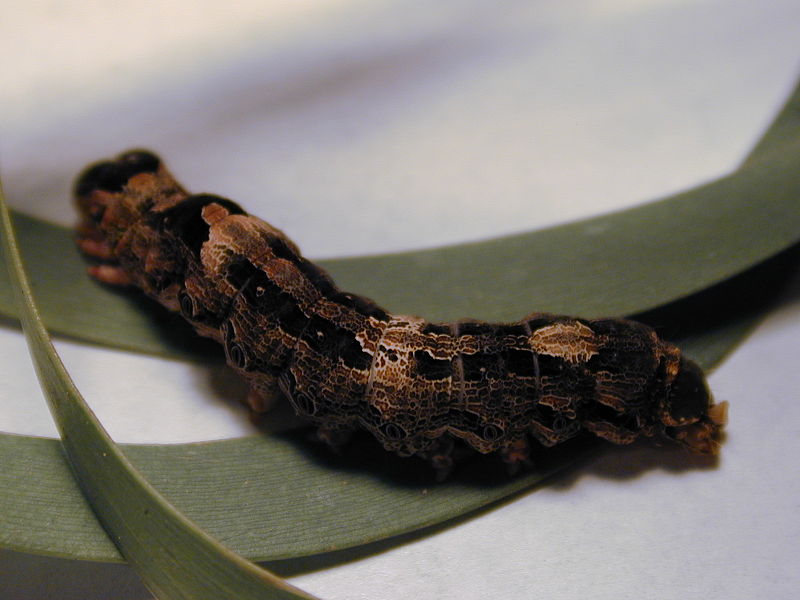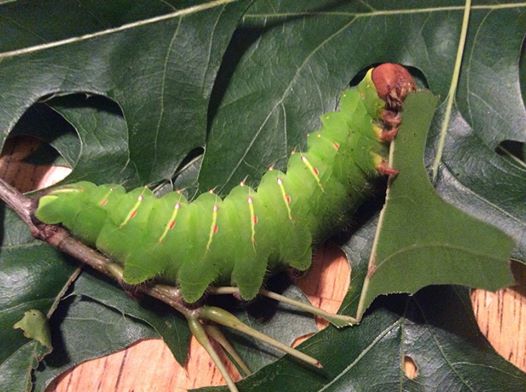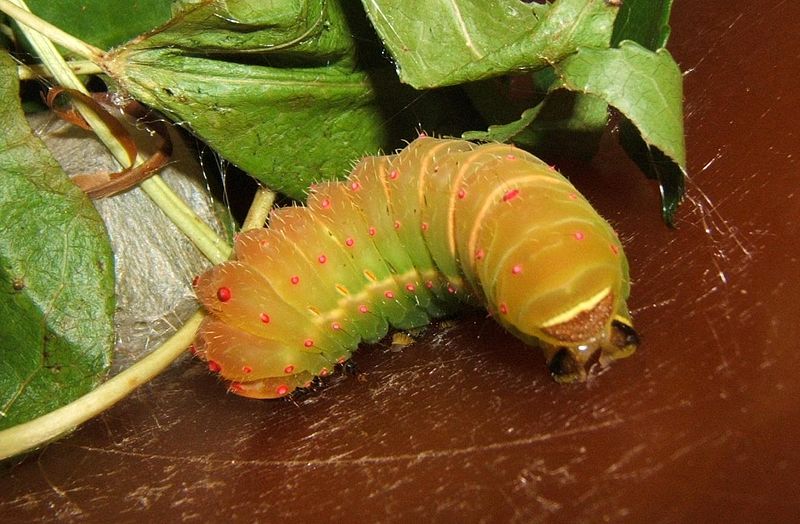National Moth Week is behind us. We really enjoyed our Malt, Hops and Moths event at Alamo Brewery last weekend–but the fun doesn’t have to stop there. The celebration of those night flying cousins of butterflies, often cast as ugly step sisters in the world of lepidoptery, can take place ANY night of the week. Just wait for darkness, turn on a light, sit back and enjoy the show.
Here’s five moths that we have in Central and South Texas right now. Open your eyes, look, and you will see them.
The Sphinx Moth
Known in its larval form as the much loathed Tomato or Tobacco Horn Worm, this attractive dusk flier also is often called the “hummingbird moth.” Gardeners despise the Manduca sexta’s consumption of their tomato plants, but I suggest setting aside a few seedlings for these voracious caterpillars, who strike a sphinx-like pose when poked, arching their neck and staring blankly at who’s bothering them.
As moths, these impressive striped flyers move during daylight hours, hovering like helicopters to nectar and provide great observation opportunities. They are members of the Sphingidae family.
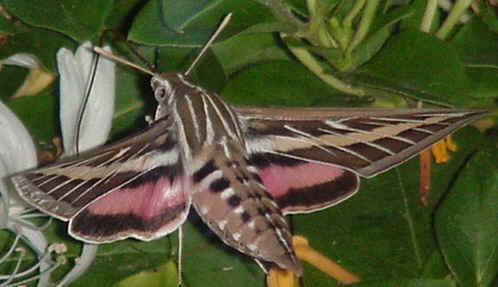
C’mon, admit it: she’s adorable. Sphinx Moth, photo courtesy Colorado State University extension office
Black Witch Moth
Large, bat like and harmless, the intriguing Ascalapha odorata, sometimes known as “the bat moth” resembles a bat in size and shape, and with its seven-inch wingspan is the largest moth in North America. They are common in these parts.
They often hang out near doors and flush when approached, causing quite a startle for the unsuspecting. But remember, they’re completely harmless. Much folklore surrounds their appearance. Throughout the hemisphere, legend has them bringing good luck, a lottery win, or a death in the family, depending on the part of the world and the circumstances of their appearance.
In the movie Silence of the Lambs, serial killer Hannibal Lechter inserted cocoons of Black Witch Moths into the mouths of his victims as a weird gesture of transformation. The moth on the movie poster is a Death’s Head Hawk Moth, but the actual cocoon was that of a Black Witch.
Polyphemus Moth
The Polyphemus Moth, Antheraea polyphemus, sports prominent, owl-like eye spots and a six-inch wingspan. The moth is dramatic. We had a hatch of these guys at the ranch one night and several fluttered against the porch spotlights. The sound of their wings hitting the the floodlight was so loud, you would have thought birds or bats had paid a visit.
The Polyphemus gets its name from the Greek myth of the Cyclops Polyphemus (cyclops means one-eyed giant). They’re not unusual and live everywhere in the U.S. and Canada. That they host on a variety of trees–oaks, birches, elms, willows and others–perhaps explains their widespread provenance.
Like many moths, these members of the Saturnid, or silk moth family, spend most of their life as caterpillars, eating up to 86,000 times their body weight at emergence in just two months. Once they become a moth, however, their vestigial mouth parts make eating impossible. Basically, their mouths don’t work any more. Their sole focus as a moth is to reproduce.
Polyphemus change dramatically during the caterpillar cycle and in their final instar become a fantastic three- or four-inch green caterpillar with silver and/or red spots on the side. See the photo above by our friend Mona Milller.
Ailanthus Webworm Moth
The first time I spotted one of these handsome creatures at the ranch I thought it was beetle. They tuck their wings in a tidy fashion, leading you to believe they are of a different genre, but no–they are moths.
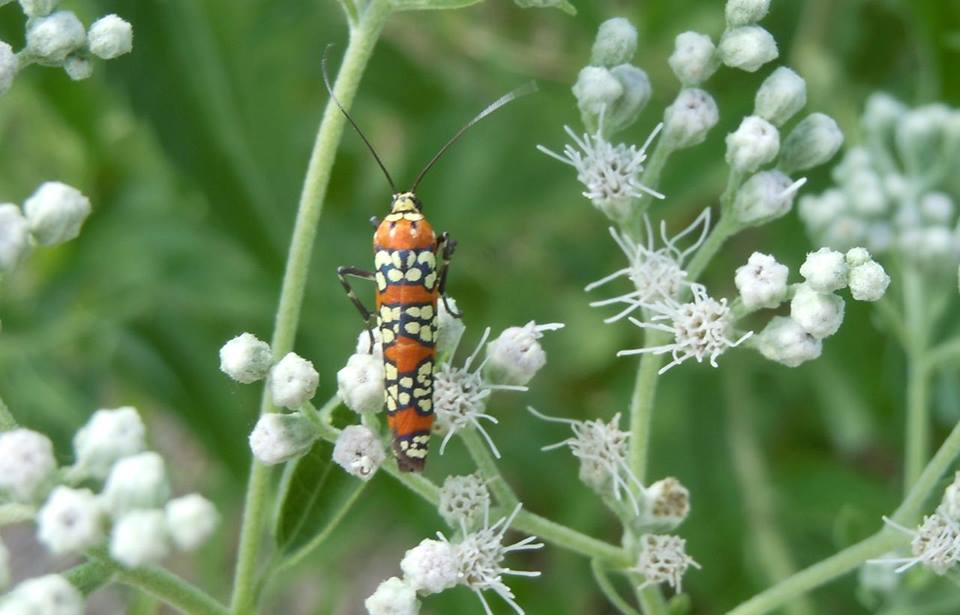
This guy fooled me. Thought he was a beetle, but no, it’s the Ailianthus Webworm Moth. Photo by Monika Maeckle
Members of the ermine moth family, the small, striped Atteva aua caterpillars build communal nests in the Ailanthus tree by pulling leaves together with webbing and spinning cocoons inside the webs. They are native to Central America, but migrate north in the summer and host on the Ailanthus tree, sometimes called the Tree of Paradise. Both the AWM and the Ailanthus tree are introduced species that have adapted. Non native, but gorgeous creatures.

Ailanthus Webworm Moth caterpillars are an introduced species, just like the tree they host on. Photo via www.urbanwildlife.net
Luna Moth
This beauty, Actius luna, is one of the most dramatic moths that take to the night. The lime green beauties host on various hardwoods and are apparently found in our area, although I have never seen one.
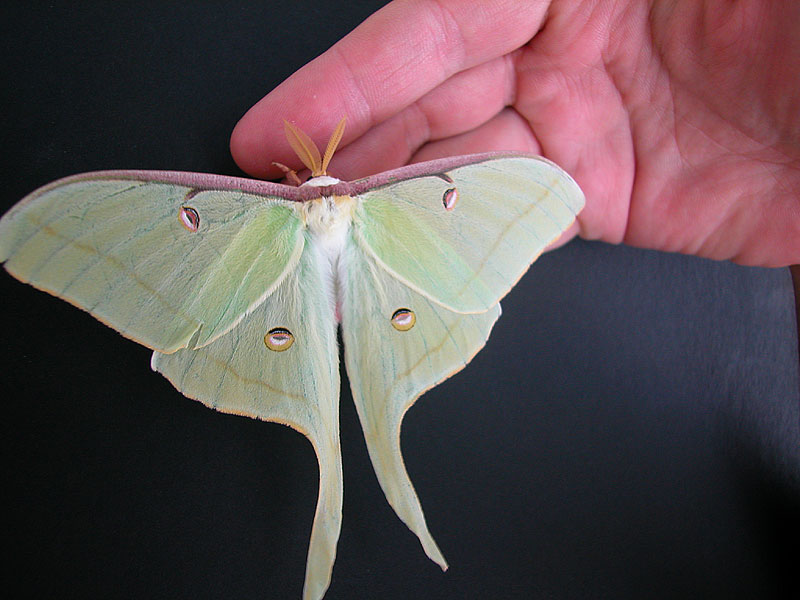
One of the most dramatic moths, the long-tailed glamourous Luna Moth. Photo bu Mike McCafferty, via Wikipedia
In their caterpillar stage, Luna Moths are equally impressive, with chubby green body sections punctuated by prominent gold-brown-orange pegs. Like many moths, they only live a week as adults. For that period, they do not eat (they have no mouth parts). Their singular goal is to reproduce.
Good luck hunting moths. Please let us know what you find.
Related posts:
- Moth Night: Lotsa MOTH-ers, Few Moths, $1K raised for FoSANA
- Q&A: Interview with National Spokesmoth Manduca Sexta, Sphinx Moth Says Moths Get No Respect
- Join us for Malt, Hops and Moths: Moth Night at the Alamo Brewery, July 23
- Four Fine Texas Moths for National Moth Week
- Large, Batlike and Harmless: Black Witch Moth Making Appearances in South Texas
- Happy Pollinator Week! Unpaid Workers of Food Web Deserve Respect and Resources
- Genista Moth Caterpillars Return to Llano River Mountain Laurels
- IH 35 to Become Pollinator Corridor for Bees, Monarch Butterflies, Other Pollinators
- Endangered Species Act: Wrong tool for the Job of Monarch butterfly Conservation?
- Tropical milkweed: Ok for Monarch Butterflies, “Just Cut the Dang Stuff Down”
- Wildly Successful: Pollinator Powwow Draws Hundreds from Texas and Beyond
Like what you’re reading? Follow butterfly and native plant news at the Texas Butterfly Ranch. Sign up for email delivery, like us on Facebook, or follow us on Twitter, @monikam.


